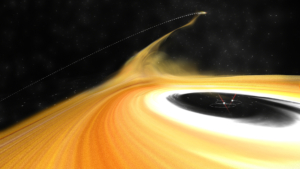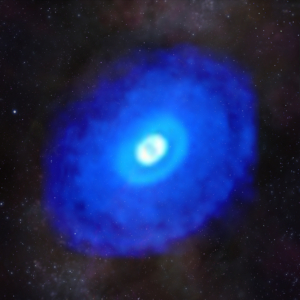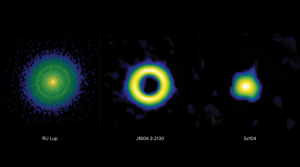Astronomers have discovered more than 5,000 planets orbiting other stars. We now know that most stars have orbiting planets…
ALMA Catches “Intruder” Redhanded in Rarely Detected Stellar Flyby Event
Scientists using the Atacama Large Millimeter/submillimeter Array (ALMA) and the Karl G. Jansky Very Large Array (VLA) made a rare detection of a likely stellar flyby event in the Z Canis Majoris (Z CMa) star system. An intruder—not bound to the system—object came in close proximity to and interacted with the environment surrounding the binary protostar, causing the formation of chaotic, stretched-out streams of dust and gas in the disk surrounding it.
The Baseline 9: How Do Exoplanets Form? Mind The Gaps!
Young stars often have disks of gas and dust around them, and many of these disks have gaps within them. How do astronomers know that these gaps are caused by young planets and not some other effect?
ALMA Reveals Carbon-Rich, Organic Birth Environments of Planets
An international collaboration of scientists using the Atacama Large Millimeter/submillimeter Array (ALMA) has completed the most extensive chemical composition mapping of the protoplanetary disks around five nearby young stars at high resolution, producing images that capture the molecular composition associated with planetary births, and a roadmap for future studies of the makeup of planet- and comet-forming regions. The new study unlocks clues about the role of molecules in planetary system formation, and whether these young planetary systems in the making have what it takes to host life.
Mind the Gap: Scientists Use Stellar Mass to Link Exoplanets to Planet-Forming Disks
Using data for more than 500 young stars observed with the Atacama Large Millimeter/Submillimeter Array (ALMA), scientists have uncovered a direct link between protoplanetary disk structures—the planet-forming disks that surround stars—and planet demographics. The survey proves that higher mass stars are more likely to be surrounded by disks with “gaps” in them and that these gaps directly correlate to the high occurrence of observed giant exoplanets around such stars. These results provide scientists with a window back through time, allowing them to predict what exoplanetary systems looked like through each stage of their formation.
Study of Young Chaotic Star System Reveals Planet Formation Secrets
A team of scientists using the Atacama Large Millimeter/submillimeter Array (ALMA) to study the young star Elias 2-27 have confirmed that gravitational instabilities play a key role in planet formation, and have for the first time directly measured the mass of protoplanetary disks using gas velocity data, potentially unlocking one of the mysteries of planet formation.











